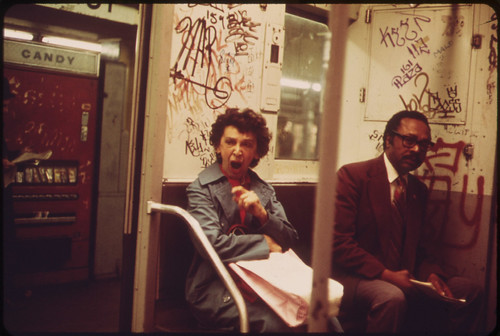On Loving (and Not Loving) the MTA

“Well, move the damn bus then.”
This is the very angry voice of not so visibly-perturbed woman. She’s upset because the Bronx-bound shuttle we are on has been idling for twenty minutes.
“This is a 149th Street express bus,” the driver howls into the speaker.
“Well, move the damn bus then.” Same controlled tone, elevated to the point of being loud. But it’s not shrill, somehow. The bus driver’s eyes flick to his mirror, and you can tell he is trying to spot who keeps yelling back at him. But the bus is jammed with people, so from his vantage it could be anyone.
This goes on for a while, quickly going from marginally exciting to slightly vexing. The woman was annoyed, perhaps rightfully so. Track work had shut down service for her train, which she found out without much warning. She was then herded upwards, handed a yellow slip of paper, and advised to wait in the sun. This was enough to make even the most calm people upset.
On the other hand, the track work that had displaced her and added time to her commute was done for her benefit, to stave off future possible malfunctions that would make a later commute exponentially more unbearable. So perhaps she was overreacting.
The average New Yorker’s relationship with the MTA resembles in many senses the average New Yorker’s relationship with her own limbs. When things are working well, as they usually are, they are invisible. Trains, like movements, are ushered in with little or no fuss. They become extensions of the body, with movements as fluid as they are scheduled and controlled. The problem, of course, emerges when these trains (or buses or ferries) cramp or tear or are otherwise strained. It’s here that riders face delays and service cuts, the latter of which is the transportational equivalent to an amputation. When the MTA hurts, we hurt.
Dangling above every man, woman, and child who rides an MTA vessel is the constant threat of that amputation. Service cuts are the bane of any transportation rider, and a large part of that stems from their nasty habit of sneaking up on us. But we tolerate them insofar as much as we can. We excuse the abysmal late-night service, and look past the painful weekend construction. These are necessary evils, and we endure them. We can’t however, look past – and I almost can’t bear to write it – fare hikes.
If there is one thing that the average broke-ass feels quite keenly, it’s an increase in the cost of transportation. An expensive train fare isn’t an especially invisible one, and paying $2.25 for something you not so long ago paid $2.00 for has a way of eliciting indignation. This umbrage is heightened somewhat when that same fare hike is accompanied by service cuts and constant delays. There is only so much people can take.
And yet they take it all. As the collective purse strings grow tighter and tighter, and as (mostly) everyone scrambles to answer the question of where the hell all the money went, people are forced to do more with less – or, in the MTA’s case, to charge more for less. Hypothesizes abound for what the cause of the MTA’s perennial budget concerns is. Some say its the transportation workers’ union and the fiscal vice-grip that it has on the MTA’s cojones. This seems logical. By some numbers, 60% of the MTA’s budget goes to payroll, pensions and overtime. That’s $7 billion. One recently-retired LIRR worker made $239,000, which may sound crazy to you because it is. That’s a lot of money.
Other hypotheses point to the dreadful level of funding that the MTA gets from the state and city governments, funding that only seems to decrease from year to year. This has necessitated that the MTA, a public benefit corporation, borrow to complete projects. This means debt, and as anyone who has been to college knows, debt is fucking awful.
The truth is likely somewhere in between. Running a transportation system isn’t easy, especially when that transportation system serves a third of transit riders in the country. And yet, all told, the MTA does a fairly good job of it. Personal quibbles and intricately detailed horror stories aside, the MTA gets riders to where they need to go. And the simple fact is this: MTA riders may grumble and complain, but the reality is that transit riders do not pay for the full cost of the service they use. Public transportation is fueled by subsides that hinge on the logic of public good. Trains and busses keep cars off the road, and New York would not be what it is today without the exhaustive system that runs beneath its streets. The service that the bureaucratically chaotic MTA runs is a public good, a frustrating, increasingly-expensive public good.
Which is what I want to tell the woman who is yelling at the the bus driver. There is humanity on both sides of their dispute. The driver just wants to do his job, and the woman just wants to get home. If only the driver would move the damn bus.







